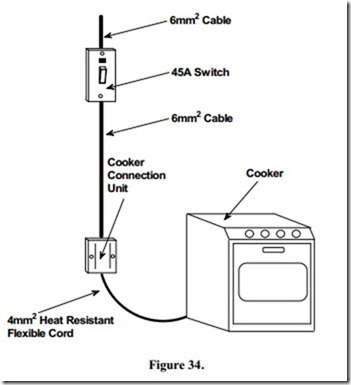The Electric Cooker
A basic domestic electric cooker consists of four boiling plates or rings, a grilling element and an oven. The controls for each element may be grouped together on a rear control panel or be situated on the front of the main cabinet. More expensive cookers usually have such features as, automatic oven timers, oven lights, rotisserie etc.
To ascertain the total loading of an electric cooker, the loading of the individual elements, motors, lights etc. must be added. For example, the total load of a typical electric cooker is comprised of the following loads:
Cooker Installation
A separate final circuit should be employed to supply a cooker. It should be connected to a separate way on the distribution board and terminated at a cooker switch. This switch should be a Double Pole type rated at a minimum of 45 A. The switch feeds a cooker connector unit, which may be made “live” even when not connected to a cooker. A heat-resistant flexible cord should be used to connect between the connector unit and the cooker. A cooker circuit is normally wired in 6 mm2 cable and 4 mm2 flex, protected by a 32 A MCB or fuse.
Cooker
The cooker switch should be installed to one side of the selected cooker position. It should be not more than 2 metres from the cooker.
The flexible cord from the cooker to the connector unit should be long enough to allow the appliance be moved out for cleaning and maintenance purposes.

